Y2K–2005
What’s hot now? What was hot just after the Y2K rant and rave? What’s changed? In addition to looking closely at results of the 2005 EDUCAUSE Current Issues Survey,1 this article considers six years’ worth of trends as measured by what campus leaders have seen as the most critical IT challenges in higher education.
Current Issues 2000–2005
EDUCAUSE inaugurated its annual Current Issues Survey in 2000 by asking the primary representatives, typically CIOs, of its member institutions to identify up to three critical IT issues (five starting in 2004) from among 30 to 40 in response to each of four questions (see Table 1). The survey response rate has typically been 35 to 40 percent, with a representative spread among all institutional sizes and types, showing a high level of interest in this annual pulse-taking.
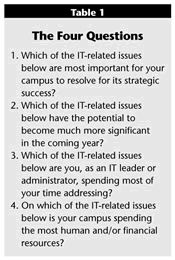
Click image for larger view.
Each year, the Current Issues Committee, while trying to preserve a stable, comparative group of issues from which to choose, has adapted the survey to newly emerging issues, such as Collaboration/Partnerships, Enterprise-Level Portals, and Research Support, as well as to evolving nomenclature, such as Converging Technologies, E-Learning/Distributed Teaching and Learning, and Security and Identity Management.
The Current Issues Committee has analyzed and reported annually on the top-ranked IT issues, presenting detailed demographic breakdowns and noting significant changes from recent years. With this article, we introduce a new element: an organized presentation of the top-five issues for all questions over the complete six-year history of the survey.2 Beyond simply presenting the top five issues, for the first time we show their relative importance, or weight, in terms of frequency of citation across all respondents. Figures 1 though 4 use a Z score transformation to convert total issue citations to a standardized scale. The length of the vertical interval between issues represents their relative aggregate importance to the IT leaders who responded to the survey. Where there is no interval line between two or more issues, there was no significant difference in their weights.
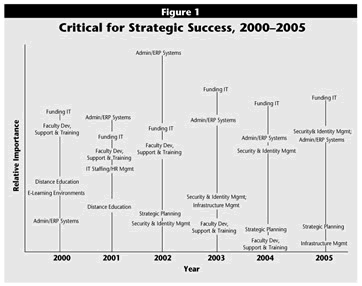
Click image for larger view.
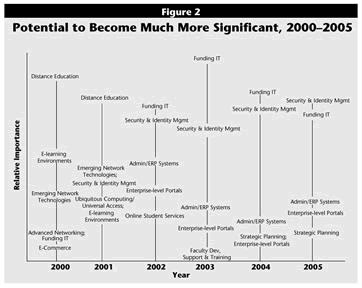
Click image for larger view.
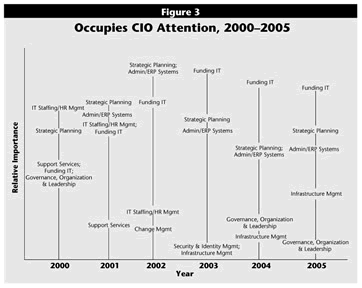
Click image for larger view.
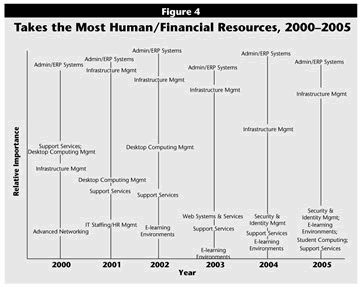
Click image for larger view.
Most Stable Issues (Based on Ranking)
Which top-five issues for all institutions have remained the most stable in terms of ranking since 2000?
Critical for Strategic Success
Funding IT has been ranked number one or number two for all six years of the survey and has remained the top issue for the past three years (see Figure 1). The only other issue in this category to have been consistently ranked in the top five since 2000 is Administrative/ERP/Information Systems.
Potential to Become Much More Significant
As might be expected, Security and Identity Management has appeared as one of the top three issues with acceleration potential in five out of six years, rising to number two in 2002 and number one for the first time in 2005 (see Figure 2). The three other stable issues in this category are Funding IT (number one in 2002, 2003, and 2004 and number two in 2005); Administrative/ERP/Information Systems (number three for four years straight, starting in 2002); and Portals (Enterprise Level) (ranked fourth or fifth since 2002).
Occupies CIO Attention
Funding IT and Strategic Planning consume the greatest amount of the CIO’s time and energy, having placed in the top five in all years since 2000 (see Figure 3). Strategic Planning has been consistently ranked either first or second, while Funding IT has been number one for the past three years. Administrative/ERP/Information Systems rounds out this category as second or third for the past five years.
Takes the Most Human and/or Financial Resources
Of all issues in all categories, Administrative/ERP/Information Systems has the highest consistency in this category as the number-one drain on campus resources for all six years of the survey (see Figure 4). Following closely on its heels is Infrastructure Management as number two for the past five years.
Most Volatile Issues (Ranking Changes and Relative Importance)
Which issues’ rankings have changed most dramatically, have appeared and disappeared, and/or have shown the greatest relative importance among the top-five issues across all six years, 2000–2005?3
Critical for Strategic Success
In 2002, the first year following the September 11, 2001, terrorist attacks, Security and Identity Management first appeared among the top five on this measure. As Figure 1 shows, in 2003 it jumped two positions to number three, and although it held that position in 2004, its relative importance increased dramatically, approaching that of Administrative/ERP/Information Systems, the second-ranked issue, and far outweighing Strategic Planning, number four. In 2005, Security and Identity Management became second only to Funding IT in critical importance.
Another historically volatile issue in this category is Administrative/ERP/Information Systems, which jumped from number five to number one in just one year, from 2000 to 2001. In the following year, 2002, it remained at the top but with significantly greater importance than the second-ranked issue, Funding IT. When it dropped from first to second in 2003, Administrative/ERP/Information Systems still maintained the same relatively greater importance over the next lowest ranked issue, Security and Identity Management.
Other issues appearing for the first or last time among the top five considered critical for strategic success have included E-Learning Environments (last in 2000); Distance Education (last in 2001); Infrastructure Management (first in 2003); and Faculty Development, Support, and Training (last in 2004).
Potential to Become Much More Significant
It is instructive to compare issues that made the top five in the potential-to-become-more-significant (PBMS) category (Figure 2) in a given year with those cited the following year in the critical-for-strategic-success (CSS) category (Figure 1) to see if concerns and anxieties were borne out. Distance Education is a case in point: It held the number-one position for PBMS in 2000 and 2001—with significant importance intervals between it and the second-ranked issues in both years—and then dramatically disappeared from the top five in 2002. On the CSS scale, it was already number three in 2000, dropped to fifth in 2001, and did not make the top five at all in 2002. While not a boom-to-bust story, this precipitous movement on both scales illustrates that Distance Education, which had seemed to be the next big thing for a critical mass of campuses at the beginning of the decade, lost its broad luster as venture capital experiments succeeded or failed, for-profit education took a larger share of this emerging market, and a smaller subset of traditional accredited institutions decided that this was an appropriate long-term component of their missions.
Other issues with notable movement in the PBMS top five include:
- Funding IT: after dropping off in 2001, reappeared and jumped to number one in 2002, a position it held until 2004, dropping to number two in 2005
- Security and Identity Management: first appeared in 2001 as number three, moving to number two in 2003 and number one in 2005
- E-Commerce: last appeared in 2000
- Ubiquitous Computing/Universal Access: first and last appeared in 2001
- Portals (Enterprise Level): first appeared in 2002
- The importance interval between first-ranked Funding IT and second-ranked Security and Identity Management increased significantly in 2003; in 2004 and 2005, both issues clustered at the top with notably higher importance than third-ranked Administrative/ERP/Information Systems.
Occupies CIO Attention
Along with resource expenditures, this is the least volatile of the four categories, reflecting the relative stability of IT leaders’ roles (see Figure 3).
- Staffing/HR Management: number one in 2000, dropped to number three in 2001 and to number four (and last appearance) in 2002
- Governance, Organization, and Leadership for IT: disappeared after 2000 but reappeared in 2004
- Security and Identity Management: first and last appeared in 2003
- Infrastructure Management: first appeared in 2003
Takes the Most Human and/or Financial Resources
Very stable at the top (Administrative/ERP/Information Systems and Infrastructure Management ranked first and second since 2001), this category shows ebb and flow in the third through fifth positions and principally in 2000–2002 (see Figure 4).
- Infrastructure Management: fourth in 2000, rose to second in 2001 where it has remained
- Support Services: second in 2000, dropped to fourth in 2001
- Desktop Computing Management: third from 2000 to 2002 and then disappeared
- Staffing/HR Management: first and last appeared in 2001
- E-Learning Environments: first appeared in 2002
- Web Systems and Services: first and last appeared in 2003
- Security and Identity Management: first appeared in 2004
The widest importance intervals have occurred between first-ranked Administrative/ERP/Information Systems and second-ranked Support Services (2000); second-ranked Infrastructure Management and third-ranked Desktop Computing Management (2001); second-ranked Infrastructure Management and third-ranked Web Systems and Services (2003); and second-ranked Infrastructure Management and third-ranked Security and Identity Management (2005).
2000–2005 Summary Observation
The relatively stable positions of Funding IT and Administrative/ERP/Information Systems at or near the top of all four measures of important issues over the past six years show them to be the abiding twin foci of IT in higher education as perceived by leaders in the profession. Following closely in recent years among issues critical for institutional success and holding CIOs’ attention are Infrastructure Management and Strategic Planning. Issues that seemed important and consumed considerable resources early in the decade—Desktop Computing and Distance Education—moved lower and then disappeared completely from the top five, either because they were no longer critical to some institutional missions or because effective planning and leadership lowered their significance on leaders’ radars. However, in line with the caveat stated at the beginning of the Most Volatile Issues section above, it is worth noting that Distance Education has emerged as a major consumer of resources for associate’s institutions in 2005.
Issues that have appeared and then dropped off the top five—Ubiquitous Computing/Universal Access, Staffing/HR Management, Online Student Services, and Change Management—have made way for the rising challenges of E-Learning Environments, Portals (Enterprise Level), and Security and Identity Management.
Someone paying close attention for the past six years might look at a particular trend, give a shrug of the shoulders, and say, "So what? I saw this coming and addressed it on my campus." Of the same trend, another might say, "That’s not been my or my campus’s experience. The survey must be skewed by one demographic or another." The point is that six years of data from the EDUCAUSE Current Issues Survey show our profession behaving like any other that is robust, diverse, and advancing its institutions’ missions: Certain stable touchstones define our most compelling issues over time, just as there have been older issues replaced by newer ones that now shape the technologies and services surrounding the learning enterprise and figure more centrally in the broader institutional mission. This is surely as it should be.
2005 Survey Findings: All Respondents
For the 2005 survey, more than 36 percent (603) of the 1,653 EDUCAUSE primary member representatives completed the Web-based survey in December 2004. Survey participants were asked to check up to five of 30 issues in response to each of four questions (see Table 1 for the questions and Table 2 for the issue choices).
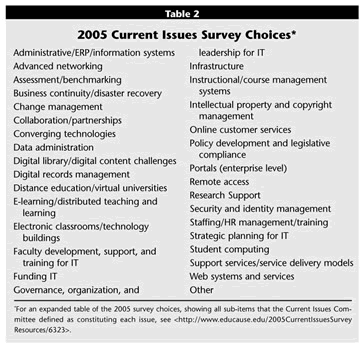
Click image for larger view.
Two overall findings for all institutional respondents to this year's survey are especially notable. First, for the third year in a row, Funding IT remains the number-one IT-related issue in terms of its strategic importance to the institution (Question 1) and its consumption of IT leaders’ time (Question 3). The increasing cost of securing campus information environments, acquiring and maintaining administrative systems, and enhancing network infrastructure; heightened national scrutiny of the cost of higher education; and continuing strain on, if not further reductions in, state budget allocations to public institutions—all contribute to this issue’s stability at the top.
Second, news accounts in 2004 and early 2005 of information-security breaches at several high-profile universities underscored the attention that has placed Security and Identity Management among the top-ten issues on all four measures—strategic importance, growing in significance, demanding the campus IT leader’s time, and expenditure of human and fiscal resources. Perhaps more important than security breaches that get prominent media attention is the fundamental issue of individual computer vulnerability that can turn machines into open doors or worse. Without a comprehensive plan to protect institution-owned as well as personally owned computers connected to the network from virus/worm/malware attacks, there can be no reasonable level of reassurance. In 2005, Security and Identity Management moved from third to second on the list of issues critical to resolve for institutions’ strategic success and from second to first among those issues expected to become even more significant in the coming year.
Comparing responses across all questions for all respondents, four issues rank in the top ten in all four areas:
- Administrative/ERP/Information Systems
- Funding IT
- Infrastructure Management
- Security and Identity Management
Two other issues are on the top-ten lists for three of the four questions:
- Strategic Planning for IT (all but Question 4, resource consumption)
- Web Systems and Services (all but Question 3, IT leaders’ time)
How do these results compare to last year’s? With most issues either holding their rankings or only moving up or down one position from 2004 to 2005, the top-ten issues for all respondents have remained fairly stable (see Table 3).
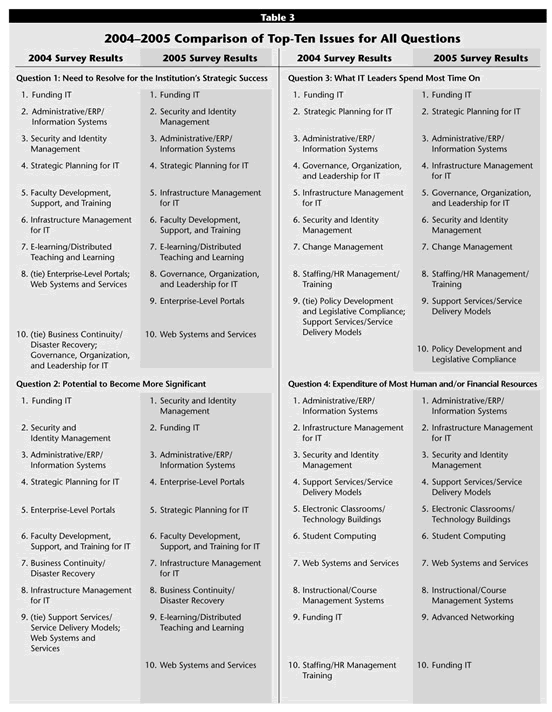
Click image for larger view.
Two changes are worth noting in this comparison. First, Business Continuity/Disaster Recovery, having first made the top-ten list of issues critical for strategic success in 2004, has dropped off in 2005, perhaps because such plans have been updated and refined due to the steady state of high attention to Security and Identity Management over the past three years. Second, IT Staffing/HR Management, ranked tenth in 2004 as consuming the most resources (human or, most likely, financial), has dropped off that list. The issue remains eighth, however, on the list of issues most occupying IT leaders’ time.
As in past years, the survey results show some differences between what issues IT leaders are spending most of their time on and the top issues for the other three questions. For the most part, the CIOs and senior IT administrators who respond to these questions are responsible for all elements of the IT organization, its current services to many campus constituencies, multi-year planning, resource management, and intersection with broad institutional goals. Thus, we would expect to have them report spending time on some things that do not typically appear in the other lists. In 2005, these are:
- Change Management
- IT Staffing/HR Management
- Policy Development and Legislative Compliance (New to the IT leaders’ top-ten list in 2004, this issue appears again most likely because of myriad legislative and campus-policy activity on such fronts as CALEA, IP-enabled services, the CAN-SPAM Act, the USA PATRIOT Act, SEVIS, HIPAA, and others.4)
2005 Demographic Similarities and Differences
The most interesting points of similarity and difference in the Current Issues Survey occur between various types and sizes of institutions. The survey tracks responses by control (public versus private), Carnegie class, and enrollment size: small (fewer than 2,000), medium (2,000 to 7,999), medium-large (8,000 to 17,999), and large (18,000+) institutions. To simplify analysis, we use four groupings based on Carnegie class: Doctoral/Research Universities Intensive and Doctoral/Research Universities Extensive are combined into Doctoral/Research; Master’s Colleges and Universities I and Master’s Colleges and Universities II are combined into Master’s; Baccalaureate Colleges–Liberal Arts, Baccalaureate Colleges–General, and Baccalaureate/Associate’s Colleges are combined into Baccalaureate; the fourth category is Associate’s Colleges (essentially community and other two-year colleges); and the fifth represents International (non-U.S.) institutions. Table 4 provides issue rankings by institution size and control and Table 5 by Carnegie and international class.
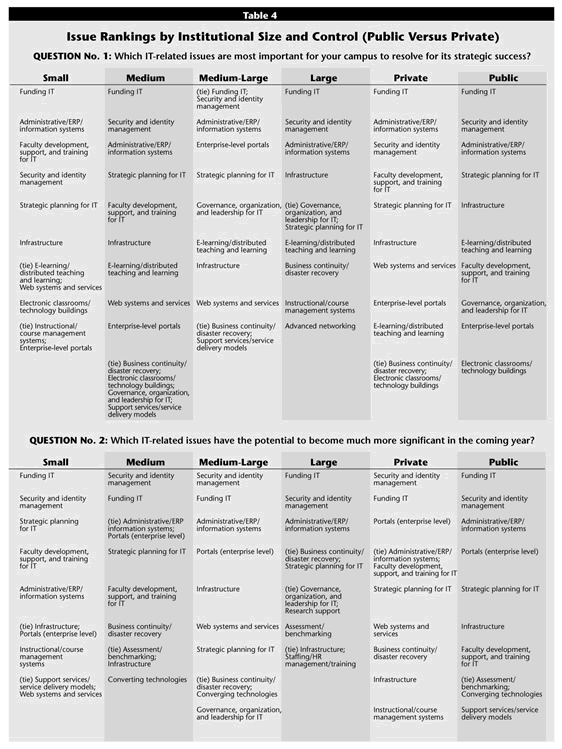
Click image for larger view.
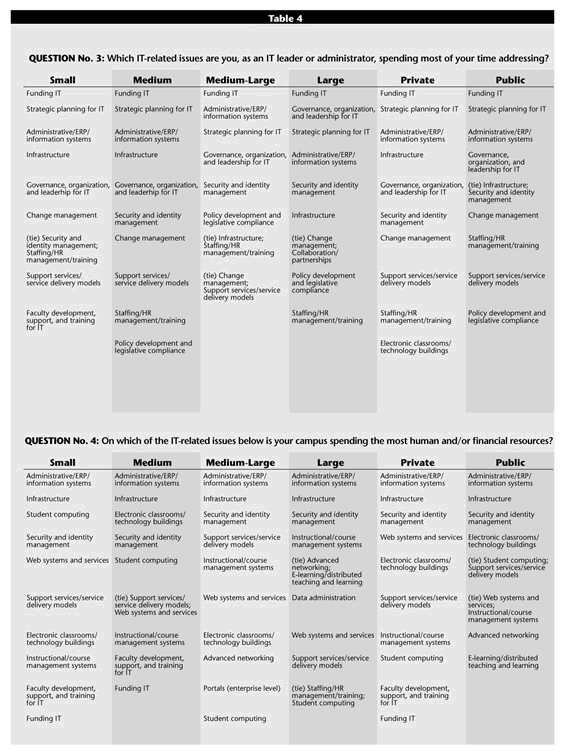
Click image for larger view.
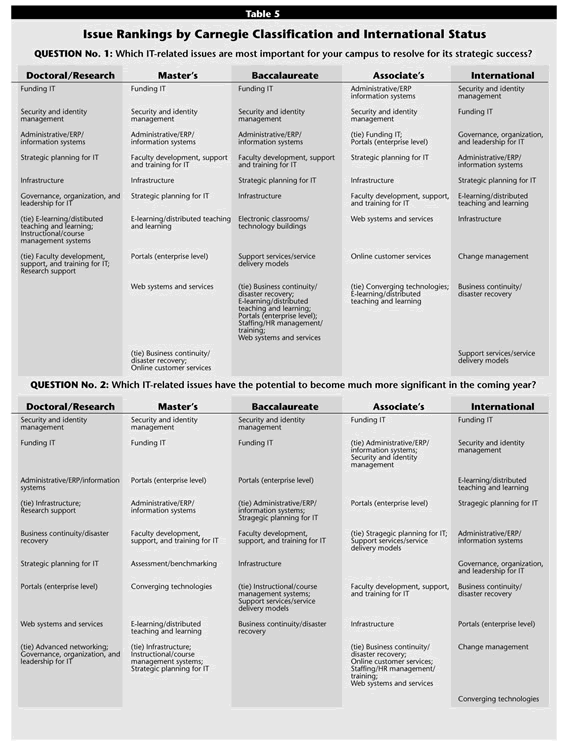
Click image for larger view.
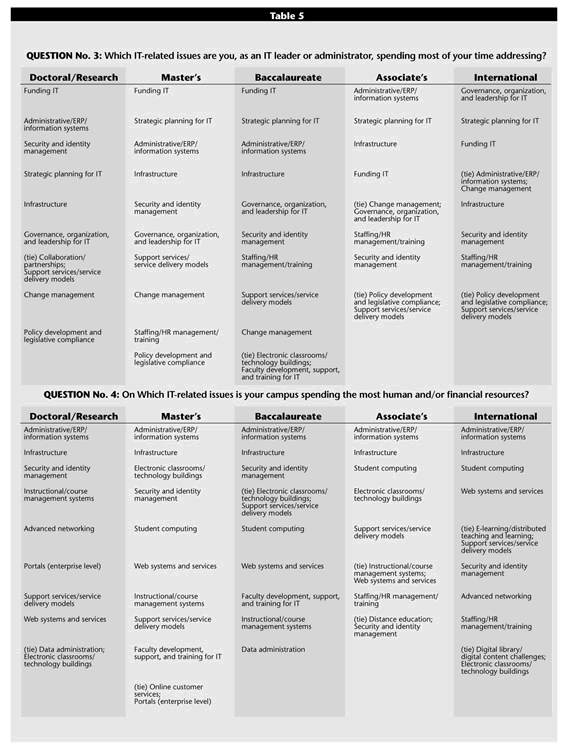
Click image for larger view.
Important to Resolve for Strategic Success
This question continues to show remarkable consistency across institutions of all sizes, control, and Carnegie class, with six of the top-ten issues considered important for strategic success appearing in all demographics. The top three are the same for nearly all:
- Administrative/ERP/Information Systems
- Funding IT
- Security and Identity Management (ranked fourth for small institutions)
Two other issues appear in the top-ten for all groups:
- Infrastructure Management for IT
- Strategic Planning for IT
Issues critical for strategic success that appear for the first time or reappear after an absence in particular demographics include Electronic Classrooms/Technology Buildings (public, private, small); Advanced Networking (large); Instructional/Course Management Systems (large, doctoral/research); Web Systems and Services (medium-large); Governance, Organization, and Leadership for IT (medium); Converging Technologies (associate’s); IT Staffing/HR Management (baccalaureate); Business Continuity/Disaster Recovery (baccalaureate); Support Services/Service Delivery Models (baccalaureate); Online Customer Services (master’s); Research Support (doctoral/research); and Faculty Development, Support, and Training (doctoral/research).
Perhaps just as significant as issues appearing for the first time or re-appearing in particular response demographics are issues that dropped completely out of the top ten: Web Systems and Services (public); Faculty Development, Support, and Training (large, medium-large); Enterprise-Level Portals (large, doctoral/research); and Business Continuity/Disaster Recovery (small, doctoral/research).
Expected to Increase in Significance
Five issues made the top-ten list for this question for all sizes, Carnegie classes, and public and private institutions:
- Administrative/ERP/Information Systems
- Funding IT
- Security and Identity Management
- Strategic Planning for IT
In this category, Security and Identity Management moved past Administrative/ERP/Information Systems for the number-two ranking in 2005.
Three other issues made the top-ten list for most of the demographic breakdowns:
- Business Continuity/Disaster Recovery (all but public, small, and master’s)
- Enterprise-Level Portals (all but large)
- Faculty Development, Support, and Training for IT (all but medium-large, large, international, and doctoral/research)
- Infrastructure Management for IT (all but international)
Issues that were expected to grow in importance—based on data from last year’s survey—for several demographic groups in 2004 but that did not appear either in this list or in the list of issues critical for strategic success in 2005 include Distance Education (associate’s), Intellectual Property and Copyright Management (small), and Policy Development and Legislative Compliance (associate’s).
Research Support,5 a new issue in this year’s survey, was ranked fourth in responses to this question from doctoral/research institutions. Converging Technologies, a new issue choice in 2004 that was ranked among the top ten by all but medium-sized and associate’s institutions, in 2005 made the top-ten list for this question for public, private, medium-large, medium, international, and master’s institutions.
Challenges Demanding IT Administrators’ Time
Funding IT is the number-one issue occupying IT leaders’ time at all but associate’s and international institutions, whose top issues are Administrative/ERP/Information Systems and Governance, Organization, and Leadership for IT, respectively. Following the top issue in this category, the most frequently cited, in descending order, are:
- Strategic Planning for IT
- Administrative/ERP/Information Systems
- Infrastructure Management for IT
- Governance, Organization, and Leadership for IT
- Security and Identity Management
New top-ten issues demanding IT leaders’ time in particular groups are:
- Electronic Classrooms/Technology Buildings (private)
- Policy Development and Legislative Compliance (associate’s)
Issues that have disappeared from particular groups’ IT leaders’ top-ten issues include:
- Collaboration/Partnerships (medium-large)
- E-Learning/Distributed Teaching and Learning (associate’s)
- Policy Development and Legislative Compliance (baccalaureate, private)
- Enterprise-level portals (large)
- Web Systems and Services (small)
How Institutions Spend Their Resources
The rubber meets the road where the most human and financial resources are allocated. For 2005, as since 2001, the number-one and number-two issues are:
- Administrative ERP/Information Systems
- Infrastructure Management for IT
Also appearing in the top ten for nearly all groups are:
- Electronic Classrooms/Technology Buildings
- Instructional/Course Management Systems
- Security and Identity Management (in the top five for all but associate’s and international)
- Student Computing
- Support Services/Service Delivery Models
- Web Systems and Services
While there is a great deal of consistency in top-ten expenditures across all demographic groups, in 2005 there is significant variation between particular groups, reflecting the different choices that IT leaders at different types of institutions must make to allocate resources in financially constrained times. Those issues tied to smaller subsets or unique to individual types include:
- Advanced Networking (medium-large, large, public, doctoral/research)
- Data Administration (large, doctoral/research, baccalaureate)
- Digital Library/Digital Content Challenges (international)
- Distance Education (associate’s)
- E-Learning/Distributed Teaching and Learning (large, public, international)
- Online Customer Services (master’s)
- Enterprise-level portals (medium-large, doctoral/research)
- Staffing/HR Management/Training (large, associate’s, international)
2005 Summary Observation
There are few surprises in this year’s survey results, suggesting a measure of IT issue stability for higher education as a whole as it continues emerging from tight budget exigencies since the dot-com bubble burst and amid increasing calls for measurable accountability. The most stable results are the first- and second-ranked sources of resource expenditure across all demographic groups: Administrative ERP/Information Systems and Infrastructure Management for IT. Almost as axiomatic, Security and Identity Management ranks high on all four of the survey radars, inching closer to the top in strategic importance and expectation to increase in importance.
The variations among demographic groups underscore expected differences in both mission and scope—Research Support emerging for doctoral/research institutions; Distance Education a major consumer of resources for associate’s institutions; Collaboration/Partnerships occupying IT leaders at large and doctoral/research institutions; Instructional/Course Management Systems expected to become more significant primarily for master’s, baccalaureate, small, and private institutions; and Governance, Organization, and Leadership for IT being especially critical for the success of medium-large, large, public, doctoral/research, and international institutions.
Hopefully this analysis of the 2005 Current Issues Survey and related resources on the EDUCAUSE Current Issues Web site (http://www.educause.edu/CurrentIssues/875) will contribute to better understanding of the broad context of IT-related issues and recognition that these issues are not just challenges for individual campuses but are prevalent throughout higher education.
Top-Ten Current Issues Defined6
While many of the top-ten issues for 2005 have also appeared in immediately past years, their natures and dimensions of urgency are constantly in flux, meriting a fresh look with each year’s survey results. Below, members of the Current Issues Committee describe the top-ten issues that IT leaders say are the most important for their institutions to resolve for strategic success (Question 1).
No. 1: Funding IT
Budget reductions, increasing demands for services, unbudgeted mandates, and escalating costs make funding IT the most pressing issue facing higher education officials. Dealing with this issue requires that key members of your institution understand the strategic value of IT and the risks associated with IT services that fail or don't meet expected levels of service. Your objective is to create an awareness of the importance of funding issues among key officials who will then want to determine realistic ways to eliminate shortfalls in funding the annual costs of critical resources and services. To provide guidance about IT funding, EDUCAUSE has published an executive briefing7; a synthesis of recent studies, in-depth interviews, and case studies8; and a "get real" opinion piece about collaborative strategies for dealing with budget challenges.9 The questions that follow are based on these publications and suggest a sequence of activities that collectively should lead to reality-based funding decisions. The questions are not meant to be exhaustive; they are intended to stimulate thinking.
- Value: Do key members of your institution understand the strategic value of IT? Can they cite examples of how IT is being or could be used to enhance teaching, learning, research, and services? Do they know how well IT is supporting the strategic goals of the institution?
- Expectations: Have key members of your institution identified the primary IT resources and services available in their schools and colleges and campus-wide? Have they specified expectations for availability, currency, and performance?
- Criticality and Risk: Have key members of your institution ranked the primary resources and services by their value to the institution? By how well they meet expectations? By the risk to the institution if the resource or service doesn't meet expectations?
- Costs: Do key members of your institution know how much is currently being invested annually to support each primary IT resource or service? Do they know what funds would be required to meet service-level expectations and the corresponding gaps in annual funding?
- Funding: Have key members of your institution aggressively pursued ways to reduce costs and reallocate savings in addition to increasing revenue? Have they considered cost-saving measures such as eliminating, reducing, or consolidating services? Or creating collaborations among institutions for shared services like disaster recovery?
No. 2: Security and Identity Management
Increased utilization of networks at higher education institutions provides exceptional opportunities for the users but also increases the risks associated with information storage, transmission, and access. Access together with regulatory requirements, distributed architectures, and hostile elements on the Internet are requiring greater expenditures and necessitate new security practices and updated policies. As stated earlier in this article, perhaps more important than security breaches that get prominent media attention is the fundamental issue of individual computer vulnerability that can turn machines into open doors or worse. Without a comprehensive plan to protect institution-owned as well as personally owned computers connected to the network from virus/worm/malware attacks, there can be no reasonable level of reassurance. Institutions need to consider the following issues:
- How will your institution balance the need for security with the tradition of open networking? Will a more secure environment be viewed as intrusive or controlling?
- Are your policies up-to-date and enforceable? Do they reflect institutional priorities and strategies, legal regulations, and best practices? Do you maintain an information-security incident-response plan?
- Do leaders recognize their roles as information stewards? Has your institution developed methods and procedures for classifying, handling, and disseminating information resources? Has your institution assessed its information, data, and services and classified these materials (for example, as public, confidential, or critical)?
- Do you maintain a separate funding mechanism for information security? Has the number of security incidents and remedial costs during the past year led to increased funding for staffing and tools? Have these incidents highlighted the risks of underinvesting in security?
- Do you have trained staff to undertake the job of security? Is there a chief information security officer or the equivalent to provide the leadership for and a focus on security? If so, do other campus units recognize this role?
- Is your institution properly responding to regulatory issues (FERPA, HIPAA, GLB Act, and USA-PATRIOT Act)? Have you taken sufficient measures to comply with these acts?
- Is your institution actively managing the risk of identity theft and other privacy issues and risks? Have you planned or completed an IT risk assessment to identify and prioritize vulnerable areas and ways to mitigate potential risks? Have you assessed and limited the use of Social Security numbers and other identifying data? Has your institution taken a position on the ownership of identifying data maintained in its systems?
- Are physical and information security maintained independently? Are security and privacy maintained independently? Are you examining the alignment of these functions?
- Do you have an information security awareness and training program? Are institutional users aware of and implementing security measures (such as patches, firewalls, and tools or techniques to combat viruses, spyware, and phishing) to protect their systems, data, and identity?
- Does the infrastructure facilitate measures to improve security? Is your institution providing funding to facilitate and support such measures on a campus-wide basis?
- Do you have a strategy to manage digital identities? Is the existing system utilizing a centralized repository, synchronization technologies, best practices, open or prestandard technologies? Do you intend to incorporate developing standards? How will you handle noncompliant systems? Have you reviewed/changed practices to minimize the risk of identity management problems caused by inadequate communication of personnel changes?
- Has your institution developed polices and identified or implemented appropriate technologies or partners to support electronic information exchange with external parties? What authentication, authorization, and transmission methods will be employed? How will you incorporate pending and new standards? Have you engaged all stakeholders in planning and decision making?
- Does your institution have the systems, procedures, and policies in place to automatically push or quickly apply critical updates and patches?
No. 3: Administrative/ERP/Information Systems
More than sixty percent of all institutions responding to the most recent EDUCAUSE Core Data Service survey reported having implemented or being in the process of implementing an Enterprise Resource Planning (ERP) system.10 In addition, the survey shows substantial commitment to other information systems that are not necessarily part of the ERP package, such as library and course management systems.
Projects of this scope demand large investment and commitment by institutional and IT leadership, both before and after implementation. Some questions that need to be addressed when considering or implementing enterprise systems include the following:
- What are the mission-critical factors driving your institution’s position on enterprise systems? What service and process improvements are expected for successful implementation? Are there viable alternatives, such as enhancing existing systems?
- If a decision has been made to implement a new system, should you partner to build or buy off the shelf? If you are purchasing a commercial product, will the functionality of the system expand to accommodate integration with course management systems, portals, and so forth?
- Is your institutional leadership committed to the decision and implementation? Will the implementation include participation by stakeholders from both technical and functional areas? How will their expectations be managed, and have they resolved data-ownership issues? Is there a communication plan to keep all constituencies informed and committed?
- Does the new system fit your institution’s technical strategy at the back-end and network levels? Does the system align with preferred data-handling strategies, such as authentication, security, and privacy?
- Will your campus adapt its business processes to the best practices configured in the enterprise solution to minimize or avoid customization? Have you identified and documented current processes and desired process improvements? Are the new functional and system requirements realistic? Will your institutional leadership support needed business process changes?
- Have you analyzed personnel needs, both in terms of staffing levels and available technical expertise, for adequate support before, during, and after implementation?
- Does your implementation partner have sufficient higher education experience, seasoned staff, and a proven track record?
- Does your support plan identify the roles and responsibilities of technical, functional, and user groups? Does it include adequate training for system users before, during, and after implementation?
- If you have completed your implementation, does your institution get more timely and intuitive access to information, especially for strategic planning and decision making? Have reengineered processes improved operations and increased efficiency? Has the system improved services for students, faculty, staff, and administrators?
No. 4: Strategic Planning for IT
Strategic planning for IT must be driven from the goals of the institution in order for technology to be seen as a vital strategic asset and not as a deployment commodity. Strategic planning needs to address the current and future needs of the students, faculty, staff, and community while incorporating instructional, operational, and research initiatives. It must delineate how technology can promote growth opportunities and innovative ideas versus focusing solely on operational efficiency or expansion of current services.
The IT strategic plan must be a collaborative cross-institutional effort with top-level sponsorship and support. It is more than aligning IT with the institutional goals; it is supporting and achieving these goals using technology. It is a continuous cycle of planning, implementing, and reviewing. The CIO’s voice must be one of many (and not the most vocal) in the development of an IT strategic plan that will be supported and championed throughout the institution. Key issues that must be addressed include:
- Sponsorship: Do you have active support from the institution’s executive and faculty leadership?
- Collaborative development: Does the planning process include cross-institutional involvement from all constituencies (faculty, staff, students, and community)?
- Integration: Does your IT plan support the institution’s goals? Does it emphasize student learning as well as institutional growth and expansion?
- Flexibility: Can your plan adapt to changing conditions and requirements? Is it open to mid-cycle innovative ideas or new programs?
- Institution-wide plan: Does it include academic/instructional programs, administrative/operational services, and infrastructure improvements?
- Chronological priorities: Does it include short-term projects (< 1 year), near-term endeavors (1–3 years), and long-term objectives (> 3 years)? Do the short-term projects support the long-term strategic objectives?
- Resources: Will you be able to provide sufficient funding for one-time and ongoing expenses? Do you have staff available with the appropriate technical skills and expertise?
- Implementation: Do your project teams include more than just IT personnel? Are project plans and timelines documented and reviewed? What needs to change in the current environment (technical, instructional, and operational)?
- Feedback/validation: What metrics do you use for assessment? Is there an annual review to learn from setbacks and celebrate successes?
No. 5: Infrastructure Management for IT
Managing the campus IT infrastructure is becoming an increasingly complex task. Institutions that seek to maximize their investment need to build in security, reliability, flexibility, and scalability. The push toward integration and services that can bring information to faculty, staff, and students any time and anywhere brings new challenges. More and more it seems institutions are viewing emerging technologies as a competitive opportunity requiring the ability to adopt and adapt quickly. Institutions face the enormous challenge of creating a workable information architecture and framework to facilitate the organization, storage, access, and maintenance of strategic data. All the while, the enterprise continues to press its demands for higher availability, bandwidth, storage, integration, and mobility.
An emerging expansion of infrastructure management is end-to-end service assurance, carrying with it a balance between component-centric and service-centric monitoring. Such a balance enables IT staff to be alerted when a service is not functioning correctly as well as when a component fails. One model of service-centric monitoring would have intelligent agents distributed strategically to launch simulated transactions in order to determine if critical services are available and if they are performing up to established service-level expectations. End-to-end service management and infrastructure component management are critically related.
Some things to consider when planning, maintaining, and upgrading your IT infrastructure include:
- Do you have a replacement plan for servers, appliances, network devices, and other hardware? Do you negotiate prepaid or long-term maintenance agreements for hardware where appropriate?
- Do you have good monitoring and benchmarking practices? Do your network and systems administrators have the tools and training to automate problem detection and notification? Are you monitoring and managing your institution’s network and Internet bandwidth requirements effectively? Do you do trend analysis to assist with capacity and upgrade planning?
- Do you have built-in redundancy for your network and critical applications servers? Do you have the necessary test environments for use when upgrading hardware and software?
- Are you effectively managing the explosive requirement for systems and storage to support your institution’s growing information architecture? Do you have a plan to deal with the development and growth of more and larger data warehouses, institutional repositories, and digital collections?
- Are you effectively meeting the current demand for both wired and wireless connectivity and infrastructure? Are you managing both environments as efficiently as possible? If voice over Internet protocol (VoIP) is in your immediate future, do you have adequate power and back-up power sources in your environment?
- Are you planning and budgeting for "environmental" upgrades? Do you know your power, generator, UPS, air-conditioning, floor-space, and fire-suppression requirements for the next three years or an appropriate planning horizon?
No. 6: Faculty Development, Support, and Training
Models for faculty development, support, and training are changing rapidly on today’s campuses. Until recently, training programs for faculty focused primarily on how to use course management systems such as WebCT and Blackboard. Rapidly emerging trends, however, underscore the need to rethink faculty support systems and training in the general move toward learning management systems. According to the Horizon Report, 2005 Edition,11 six technologies are either here or emerging for research, teaching, and learning. These include extended learning (hybrid courses using traditional, online, and mobile technologies), campus wireless environments, intelligent information management tools, educational gaming, social computing and networks, and context-aware computing. Faculty must now consider how to harness powerful communication tools, such as channels and blogs, and multimedia formats, such as streaming audio, video, digital images, and the like, in effective ways combined with traditional scholarly resources for the physical and virtual classroom. Major issues to consider include:
- What is the most appropriate model for faculty training and support? Do faculty have time to be taught, or do support personnel need to consider a production or service model? What are the physical and virtual needs for faculty support?
- How can rich content, such as digital storytelling and visual literacy, be married with technology and pedagogy? How do you evaluate such content?
- Are certain disciplines affected differently by dramatic changes in technology compared to other disciplines, and, if so, should support approaches be customized?
- What are effective organizational structures to deploy faculty support personnel? Why is it important for a variety of key experts on campus to collaborate to support faculty? How can a team effort be leveraged? What skills and training do support staff need?
- How should campuses support faculty to integrate emerging—including mobile—technologies for teaching, learning, and research? Are both the technologies themselves and their integration scalable?
- What are the incentives for faculty individually and for campuses collectively to incorporate new technologies into teaching and research? Are innovative reward structures and incentives in place?
- What are the implications for graduate student education and training as they prepare for faculty positions in high-tech environments? What are baseline computer and pedagogical literacy requirements for new faculty?
- What is the role of students in faculty development, support, and training?
- How can national and international associations’ standards and assessment work benefit local campuses seeking to measure student learning and faculty productivity?
No. 7: E-learning/Distributed Teaching and Learning
E-learning, also known as distributed learning or online distance education, has become such a significant element in postsecondary education that it is predicted that online enrollment in the United States alone will exceed one million students in 2005. Expanded e-learning opportunities are available at colleges and universities in certificate, diploma, degree, and postbaccalaureate programs. While e-learning provides many new opportunities, it also presents some unique issues and challenges, including the following:
- How are faculty best supported in an e-learning environment? What support services are needed to assist faculty, instructional designers, librarians, and media specialists in identifying or developing high-quality digital resources and using institutional information and learning-object repositories? How do we support the development of standards for the description of and access to digital resources? How do we support students and faculty in the development and use of e-portfolios?
- Whom does e-learning serve on a given campus? How do we ensure that students are informed consumers of e-learning experiences and have the personal learning, time-management, and technology skills necessary to succeed in a technology-mediated environment? How do we provide students access to the appropriate support and services needed?
- How do we provide the best possible infrastructure to support e-learning?
- How do we ensure the development of broadband networks to support multimedia in e-learning? How do we select and appropriately support course management systems? What are the opportunities and barriers associated with open source development and open architecture for such systems? How do we ensure interoperability? What changes in academic and nonacademic spaces on campus and in the community are important to enhance and enable e-learning?
- How do we ensure quality in the e-learning experience? How do we assess learning and course outcomes in an e-learning environment? How do we build an assessment model for e-learning that takes into account educational theory, recognizes best practices, and is appropriate for a variety of e-learning experiences including on and off campus, fully online, and/or hybrids, which integrate some online elements into traditional face-to-face instruction?
- What potential do new technologies such as video over IP, videostreaming, virtual reality, blogs, and online gaming environments have to enrich e-learning?
- How is e-learning being incorporated into the classroom learning experience to create blended or hybrid learning? How is this enriching teaching and learning? Is this transforming teaching and learning?
- What e-learning business model, organization, and policy structure will best serve your campus?
No. 8: Governance, Organization, and Leadership for IT
Technologies are converging; technical solutions to institutional challenges are becoming more integral to the fabric of university culture; security threats require organizational energies; and the demands for technology to support teaching, learning, and research are increasing. It is clear that CIOs across the spectrum of institutional demographics are expending significant time and effort evaluating how best to effectively lead and structure their organizations to address these and other institutional and technical challenges.
In addition to ranking eighth on the question about strategic success, Governance, Organization, and Leadership for IT was ranked fifth or above for each of the institutional types as requiring the most CIO time and attention. Effective leadership in these areas facilitates the application of technology for strategic success. But more important than leading and managing technology initiatives, budgets, and staffs, the CIO needs to build coalitions, span silo boundaries, and show how technology can advance divisional and institutional missions. As EDUCAUSE President Brian Hawkins said in a recent essay on framing the position, the CIO is both "an orchestra leader who tries to get various elements within the campus to play together" and "the leader of a jazz ensemble, who coordinates but also improvises, allowing others to express their own uniqueness and making it all up more or less on the fly."12 Following are some of the questions and issues to consider:
- Does the CIO sit on or at least interact regularly with the executive cabinet? What access does the CIO have to governing boards, community planning groups, and state legislators to influence technology decisions and priorities? Without such regular access, what can the CIO do to develop insight into how best to address issues of governance in the context of the larger institutional landscape?
- Increases in staffing and funding rarely parallel the increase in demand for services. Adjustments to service offerings, skill sets, and priorities need to be made as needs emerge. Is the IT organization flexible enough to anticipate and respond effectively?
- Is the IT organization structured properly to maximize the existing resources to accomplish institutional goals? Major organizational restructuring inherently includes significant disruption to productivity. Evaluate potential gains and setbacks when considering whether a reorganization will be beneficial. Consider other ways in which efficiencies could be realized, such as process improvements or more effective cross-functional communication. Reorganization should be accompanied by clear definition of new directions and desired outcomes, both within the IT organization and for constituent groups.
- Are the right advisory groups in place on campus to ensure comprehensive oversight of technology decisions and direction? If not, consider establishing faculty and administrative advisory groups, an IT steering committee with broad campus representation, and a means of communicating regularly with student leaders.
- How can you develop managers and future leaders within IT who are able to support the organization’s governance, organization, and leadership efforts? How should the IT organization use its knowledge, relationships, and insights to collaborate across organizational boundaries?
No. 9: Enterprise-Level Portals
Enterprise portals continue to be a prominent topic across the campus spectrum. Many campuses have embraced portal projects over the past several years, yet achieving the heralded full potential hyped by the growing portal vendor pool presents itself as an ongoing challenge for most campuses. In many cases, campuses find themselves forced to deal with multiple solutions as campus ERP and CMS projects result in the deployment of multiple portal products. The dizzying array of application-specific portal products has been complicated further by the lag in development of interoperability standards. Gootzit, Phifer, and Valdes13 observed that while the advent of Generation 3 portals has moved us toward an enterprise solution and has helped to achieve a degree of unification in a single portal framework, campuses are still left with the challenge of how to successfully integrate internal portals on different frameworks and then extend that integration to portals outside the enterprise. While the development of interoperability standards continues to evolve, Generation 4 enterprise-portal solutions may provide a tactical alternative to meeting these challenges. Generation 4 solutions will more frequently incorporate evolving architectural components such as application platform suites and smart enterprise suites. As the enterprise or horizontal portal product marketplace continues to mature in the context of rapidly incorporating these key architectural components, campuses will continue to be confronted with a large array of products from which to choose. Gartner documents no fewer than 21 separate solutions, with eight being identified as "leaders" in this important product niche.14
In the meantime, campuses confronted with the challenge of portal deployment and integration should be mindful that this product niche will continue to evolve. Gootzit, Phifer, and Valdes15 provide solid conventional wisdom for campuses to consider as they continue to manage their portal initiatives:
- What is the portal product market segment and likely survivability of your proposed or current vendors? What are the total-cost-of-ownership implications of their technology?
- Given your enterprise portal’s stage of maturity, what is the best strategy to address low-cost operations and high user satisfaction?
- What are the best practices for portal development deployment and support for your institution?
- How can you build/enhance a portal to be the unifying platform for the future—today as part of a portal ecosystem and tomorrow as the portal fabric?
No. 10: Web Systems and Services
Web services are an evolving breed of Web applications based on a service-oriented architecture that facilitates the integration of software components using a standard set of protocols. They are modular, self-descriptive, self-contained applications that interoperate over the Internet/intranet in order to publish, locate, and initiate specified functions, which can range from small single-service functions to sophisticated business procedures.
Web services are rising to prominence because they can provide a long-awaited opportunity for applications running on different platforms, programmed in a variety of languages, custom-built or vendor-acquired, to interoperate and satisfy organizational processing requirements.
Web services depend on a series of standards such as extensible markup language (XML), which describes the information to be processed; simple object access protocol (SOAP), which is the communications protocol that defines the rules for interoperability; universal description discovery and integration (UDDI), which is a directory of available Web services; and Web services description language (WSDL), which describes the capabilities and interoperability functions required for a Web Service to work effectively.
Web services promote the use of best-of-breed software applications. They eliminate the necessity of moving data and electronic processes into a common operational environment to realize integration. It is anticipated that Web services will play a dominate role in future Web-based system architectures, minimizing the complexities normally associated with application integration.
Key questions include:
- How can Web services provide optimum return on existing investments and provide enhanced scalability?
- Can you make modular/iterative development of Web-based applications—which is a hallmark of Web services—sustainable and less costly?
- Although Web services and the required standards are still evolving, what can you do to test the waters now and ensure that Web services are an integral part of future strategic plans?
- What will it take to utilize a Web services approach when developing new Web-based applications?
- What are the availability and flexibility of Web services in new vendor applications you are evaluating?
